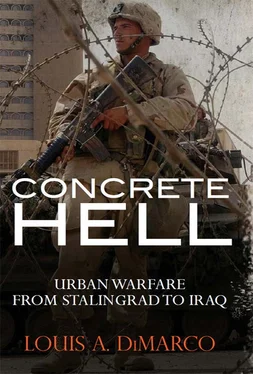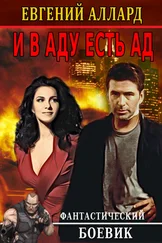The battle for Stalingrad was decided on November 23 when the Red Army managed to isolate the German Sixth Army in and around the city. In three months of combat prior to the end of November, the German forces had been unable to isolate the Soviet Sixty-Second Army in the city and therefore the battle had raged on. The Germans had never contemplated isolating Stalingrad by attacking across the Volga River. In contrast, in four days the Soviets surrounded the city and sealed the fate of the Sixth Army. Approximately 250,000 Axis troops were trapped in the kessel. Over the next two and a half months the Soviets gradually pressed against the perimeter of Sixth Army while the rest of the German army watched on helplessly. Finally, the bulk of the German troops surrendered on January 31, 1943. The remaining holdouts, after enduring a withering Soviet artillery barrage, surrendered on February 2. In all the Russians took in almost 100,000 prisoners as the five-month battle for the city ended. In total, the losses at Stalingrad were immense. In the battle and campaign, which included the Soviet counterattack, the Germans lost 400,000 men, and the Soviets lost 750,000 killed, wounded, and missing. Allies of the Germans — the Italians, Hungarians, and Romanians — lost another 130,000, 120,000, and 200,000 respectively. Thus total casualties on both sides exceeded one million men. Of the 600,000 civilians who lived and worked in Stalingrad and its suburbs, no one knows how many died, although 40,000 were reported killed in the initial air attacks against the city. Hundreds of thousands of civilians became casualties over the course of the five-month battle, and those remaining became refugees. Only 1,500 civilians remained in the city at the end of the battle. In terms of raw casualty numbers, the battle for Stalingrad was the single most brutal battle in history.
The German Tactical Approach
Though the German army had acquired experience of urban fighting during the fall of 1941, the individual divisions in Stalingrad had to develop their own version of city fighting for the unique Stalingrad situation. Stalingrad was different from other cities for several reasons. One was the massive amount of destruction that had been inflicted upon the city, destruction which continued and increased over time. The second was the nature of the buildings in Stalingrad. They were massive concrete affairs which, when surrounded by rubble following artillery and air bombardment, were virtual fortresses. The Germans found that the most effective tactic was to combine infantry and armor into teams. These teams were supported by artillery and closely supported by the Luftwaffe. Stalingrad was the last great performance by the fabled German Stuka dive-bombers.
Typically, German attacks followed a pattern: Luftwaffe air bombardment, followed by a short artillery barrage, and then the advance of German infantry followed closely by panzers in support. This pattern generally ensured success. Panzers, though not optimized for city warfare, were absolutely critical to it, and the three panzer divisions that fought at Stalingrad were a key part of most of the Sixth Army’s tactical successes. The problem the Germans had tactically was that they simply did not have enough panzers, infantry, and artillery to execute the tactics they employed with sufficient vigor to overcome the Russian defenders quickly. In the course of the German attacks in Stalingrad, virtually all the attacks were successful. However, they were never as fast as the Germans wanted or expected them to be, and were always more costly than the Germans could afford. The German army could be, and was, successful in urban combat in Stalingrad, but at an unacceptable price in time and casualties.
In the rubble of Stalingrad, the disparity between German and Soviet tactical capabilities, which was very prominent in the open battles of maneuver on the Russian steppe, was reduced significantly. The German army excelled at operational warfare: the close coordination of all arms at the division and corps level of command to achieve rapid and decisive effects across great distances. In urban combat, the important distances were blocks — divisions and corps could not maneuver, and command and coordination at the highest levels was relatively simple and not very important. Thus, the strengths of the German military machine were fairly irrelevant to the battle. Instead, the battle devolved to tactical competence at the battalion level and below, combat leadership, and the psychological strength of the individual soldier. The Wehrmacht had these characteristics in great abundance. However, so did the Soviet army. Thus, unlike in operational maneuver warfare, in urban combat the two sides were both fairly competent, and thus very evenly matched. These organizational circumstances were a recipe for a long and bloody battle. The Red Army, and in particular the Sixty-Second Army, augmented the natural strength of the Russian infantry in close combat and the urban terrain with several innovative tactics which made them more formidable in urban combat than the Germans expected.
One of the most effective and feared German weapons at Stalingrad was the venerable Stuka dive-bomber. Weather permitting, all major German attacks were preceded and closely supported by the Stukas of Luftflotte IV under Generaloberst Freiherr Wolfram von Richthofen. To lessen the effectiveness of this weapon, as well as of German artillery, General Chuikov ordered that all front-line units stay engaged as closely as possible to the Germans. The Sixty-Second Army “hugged” its German adversaries so that German bombardment could not engage the front-line Russians without hitting their own troops. This resulted in there being virtually no “no-man’s land” on the Stalingrad battlefield. Across the entire front Red Army positions were literally within hand-grenade range of the German positions. Thus, attacking Germans were often confronted by defenders who were unaffected by the pre-attack artillery or air bombardment.
After the initial penetration of the city, the Soviet armor of the Sixty-Second Army was not used in a mobile manner. The tanks, instead, were dug deep into the rubble and heavily camouflaged. Often they were invisible from more than a few yards away. They were placed on the routes most likely used by German tanks and supporting vehicles, and invariably were able to fire the first shot. The short ranges, careful preparation, and ability to fire first gave the Russian tank crews better than even odds despite the general superiority of German crews. In total the German and Soviets together employed over 600 tanks inside the city.
One of the most innovative and effective ideas developed by the defending Red Army was the idea of shock groups. Shock groups were non-standard small assault units organized to conduct quick attacks on specific German positions. They often attacked at night. Typically they consisted of 50–100 men. They were lightly equipped so that they could move quickly and silently through the city. The groups were led by junior officers; they used a variety of weapons but relied heavily on sub-machine guns and grenades. They also included engineers for breaching doors and other obstacles, snipers, mortar teams, and heavy machine guns to defend the newly won positions. Shock groups relied extensively on the initiative of the junior leaders to determine how best to assault an objective. Many of the men in the group were volunteers who relished an opportunity to take the fight to Germans, despite the Sixty-Second Army’s overall defensive stance. Because of this aggressiveness and the latitude allowed the junior leaders, shock groups were both very effective and also very much a departure from standard Soviet tactical practice which was typically very controlled. The departure from standard doctrine which shock groups represented in the Soviet army indicated the desperate measures that were permitted on the Soviet side during the battle. They proved to be a very effective tactic during the second part of the battle, after September, and were an indicator of the tactical parity that existed in close urban battle. Though shock groups were copied by other Soviet armies in subsequent urban combat during World War II, as the Soviet Union gained the operational and strategic initiative the groups became more and more standardized, larger and more heavily equipped (to include tanks and artillery). As the war progressed, they were permitted less freedom of action. Soviet shock groups, as they existed by the end of the war, bore little resemblance to the highly effective organizations developed during the battle for Stalingrad.
Читать дальше












